Think native plants and wildlife-attracting gardens look messy? It doesn’t have to be that way. In this series, we’ll talk about the techniques involved in designing a beautiful wildlife garden.
Many native plant enthusiasts and wildlife gardeners start out by trying to replicate the randomized “design” of nature, by planting a lovingly-curated collection of individual wildlife-attracting plants throughout the garden.
But the effect of this just isn’t right next to a home. A home is large and its design speaks heavily of human involvement, so going from the clean lines of a building straight to a replication of wilderness seems out of scale (wrong size) and out of place (wrong feeling).
While a home landscape should provide a connection to nature, wildlife and the seasons, it should also reflect elements of our architecture, provide comfortable places for us to spend time, and soften the strong lines of a home with plantings that feel in scale with the surroundings.
A well-designed garden is in harmony with both the human world and the natural world.
One of the simplest ways of integrating home and garden is to use large groupings of individual varieties of native or wildlife-attracting plants. By using plants in drifts or masses, we set a scene that draws the eye through our landscape in an organized way and makes our home seem more in tune with the surroundings.
When we go for the one-of-this-one-of-that approach, our eyes wander from spot to spot, which feels unsettling. Larger groups of plants “read” as one, so they feel more right-sized next to the home. And by using natives, you’re reflecting the natural beauty of your region as well as attracting local wildlife.
Drifts or masses of plants:
- Give natives instant design appeal
- Lead the eye through the garden
- Create a sense of flow and enhance the shapes in the landscape
- Have a billowing effect which is more like a grand, far-off view of nature than a close-up
- Move with the wind in a graceful way that is fun to watch
- Reflect the scale of the architecture
- Integrate home and garden
Of course, all this “reflecting the architecture” business may have you feeling worried if you go in for a softer design style. I’m not saying your plants should be planted in a straight line just so they go with the home. A meandering swathe of native grasses or perennials can emulate natural shapes such as that of a stream, yet the bold nature of the design would still fit in nicely next to a building.
Neither do you need to feel bound by a naturalistic design style just because you’re designing with natives or with natural processes in mind. Native plants can be planted in traditional or formal gardens, and can be pruned or shaped appropriately to fit in with the surroundings just as other plants can. Loads of our natives are bright enough to go in an English cottage style, have architectural forms suitable for modern landscapes, or can be pruned and manipulated to show man’s influence in a Japanese-style landscape.
There’s a horticultural benefit to planting in masses, too. Many plants use a type of chemical warfare (allelopathy) to stunt the growth of other types of plant growing nearby. By planting in drifts, your plants will cooperate with one another rather than wage war on their neighbors, and your garden will thrive with less care from you.
Here are some native and wildlife-friendly gardens that use massing effectively:
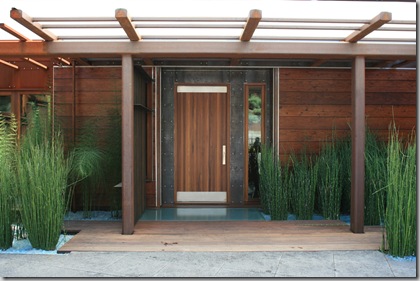 |
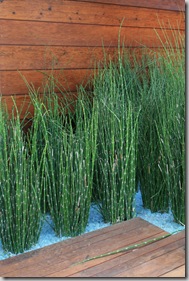 |
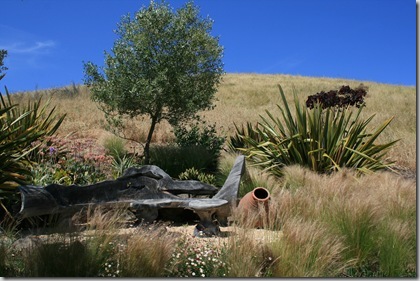 |
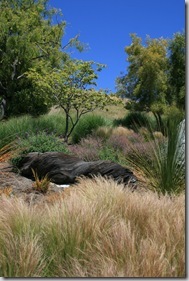 |
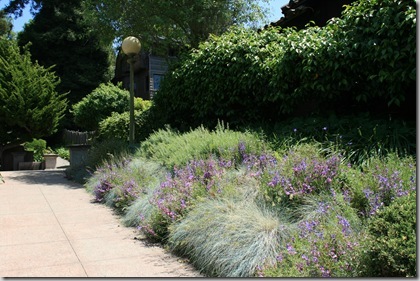 |
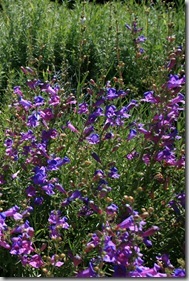 |
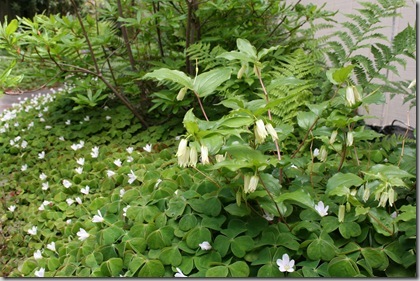 |
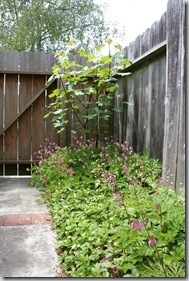 |
Next up: Choosing a Color Palette
11 responses to “Wildlife Garden Design Tip: Plant in Masses”
While this doesn’t apply to me I found it both educational and inspiring. I love the first house in the mosaic. Thanks
Thanks, Patrick! Me, too. Fun to see the variety in what people can do using native plants and others that offer benefits to wildlife.
I wonder what the plant is on the first two pictures? Some type of Rush, or? I’d like to find a plant with that form for southern Florida.
It’s Equisetum hyemale. 🙂 I don’t know what grows in Florida, but you might check with your local native plant society. I’d be shocked if you don’t have any native rushes to consider.
*Great* post and topic. You nailed it, including all the issue of scaling something in vast nature to a more finite property, especially most homes. I hope more folks start to get this…yet another gap in good xeriscape gardens is habitat vs. proven design principles. (or aesthetics with native plants, etc)
Your “wrong size” and “wrong feeling” sums it up well.
Thanks so much, David. I hold your design skills in such high regard that your words really honor me. Thanks!
Wow, these wildlife friendly gardens are really are really fascinating. Thanks for posting some photos of the garden.
[…] Gen: A thought-provoking series of questions from Carole Sevilla Brown: Do permaculturists and others who promote sustainable gardening only care about human benefit, or should we also take care to think about wildlife? […]
[…] Schmidt, a landscape designer in northern California, is writing an excellent series on design principles for the wildlife garden. Her first tip: plant in masses: By using plants in drifts or masses, we set a scene that draws […]
[…] Plant in Masses […]
[…] called allelopathy), so if you’re going to plant things close together, it’s better to plant the same variety in masses, rather than do the busy-looking one-of-this-one-of-that type of […]